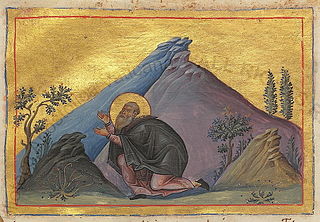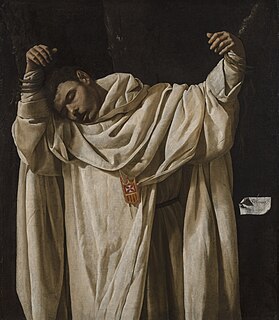
Anthony or Antony the Great, was a Christian monk from Egypt, revered since his death as a saint. He is distinguished from other saints named Anthony such as Anthony of Padua, by various epithets of his own: Saint Anthony, Anthony of Egypt, Anthony the Abbot,Anthony of the Desert,Anthony the Anchorite,Anthony the Hermit, and Anthony of Thebes. For his importance among the Desert Fathers and to all later Christian monasticism, he is also known as the Father of All Monks. His feast day is celebrated on 17 January among the Orthodox and Catholic churches and on Tobi 22 in the Coptic calendar.
Pope Zephyrinus was the fifteenth bishop of Rome from 199 to his death on 20 December 217. He was born in Rome, and succeeded Victor I. Upon his death on 20 December 217, he was succeeded by his principal advisor, Callixtus I. He is known for combatting heresies and defending the divinity of Christ.

Serapion was a Patriarch of Antioch (191–211). He is known primarily through his theological writings, although all but a few fragments of his works have perished. His feast day is celebrated on October 30.
Onuphrius or Onoufrios lived as a hermit in the desert of Upper Egypt in the 4th or 5th centuries. He is venerated as Saint Onuphrius in both the Roman Catholic and Eastern Catholic churches, as Venerable Onuphrius in Eastern Orthodoxy, and as Saint Nofer the Anchorite in Oriental Orthodoxy.

Hilarion the Great (291–371) was an anchorite who spent most of his life in the desert according to the example of Anthony the Great (c. 251–356). While St Anthony is considered to have established Christian monasticism in the Egyptian desert, St Hilarion is considered by some to be the founder of Palestinian monasticism and venerated as a saint by the Orthodox and the Roman Catholic Church.
The Sacramentary of Serapion of Thmuis is a work of Saint Serapion, bishop of Thmuis in the Nile Delta and a prominent supporter of Athanasius in the struggle against Arianism. He is sometimes called Serapion the Scholastic for his learning. He is best known in connection with this prayer-book or sacramentary (euchologion) intended for the use of bishops.
The cowl is an item of clothing consisting of a long, hooded garment with wide sleeves.

May 13 - Eastern Orthodox Church calendar - May 15

Byzantine emperors dress changed considerably over the thousand years of the Empire, but was essentially conservative. The Byzantines liked colour and pattern, and made and exported very richly patterned cloth, especially Byzantine silk, woven and embroidered for the upper classes, and resist-dyed and printed for the lower. A different border or trimming round the edges was very common, and many single stripes down the body or around the upper arm are seen, often denoting class or rank. Taste for the middle and upper classes followed the latest fashions at the Imperial Court. As in the West during the Middle Ages, clothing was very expensive for the poor, who probably wore the same well-worn clothes nearly all the time; this meant in particular that any costume owned by most women needed to fit throughout the full length of a pregnancy.

A religious habit is a distinctive set of religious clothing worn by members of a religious order. Traditionally some plain garb recognizable as a religious habit has also been worn by those leading the religious eremitic and anchoritic life, although in their case without conformity to a particular uniform style.

The Monastery of Saint Macarius The Great also known as Dayr Aba Maqār is a Coptic Orthodox monastery located in Wadi El Natrun, Beheira Governorate, about 92 km (57 mi) north-west of Cairo, and off the highway between Cairo and Alexandria.
Saint John of Egypt,, also known as John the Hermit, John the Anchorite, or John of Lycopolis, was one of the hermits of the Nitrian Desert. He began as a carpenter but at the age of twenty-five began to live a life of solitude.

The preservation of fabric fibers and leathers allows for insights into the attire of ancient societies. The clothing used in the ancient world reflects the technologies that these peoples mastered. In many cultures, clothing indicated the social status of various members of society.

Twelfth century European fashion was simple and differed only in details from the clothing of the preceding centuries. Men wore knee-length tunics for most activities, and men of the upper classes wore long tunics, with hose and mantle or cloaks. Women wore long tunics or dresses. A close fit to the body, full skirts, and long flaring sleeves were characteristic of upper-class fashion for both men and women.

Serapion of Algiers was an English Catholic Mercedarian priest and martyr. Thomas O'Loughlin says Serapion was Scottish by birth. Serapion is acknowledged as a proto-martyr. He was the first of his Order to merit the palm of martyrdom by being crucified and cut to pieces.
The Medieval period in England is usually classified as the time between the fall of the Roman Empire to the beginning of the Renaissance, roughly the years AD 410–1485. For various peoples living in England, the Anglo-Saxons, Anglo-Danes, Normans and Britons, clothing in the medieval era differed widely for men and women as well as for different classes in the social hierarchy. The general styles of Early medieval European dress were shared in England. In the later part of the period, men's clothing changed much more rapidly than women's styles. Clothes were very expensive and both the men and women of lower social classes continued to wear them until the garments were in such disrepair that they needed to be replaced entirely. Sumptuary laws also divided social classes by regulating the colors and styles these various ranks were permitted to wear. In the early Middle Ages, clothing was typically simple and, particularly in the case of lower-class peoples, served only basic utilitarian functions such as modesty and protection from the elements. As time went on the advent of more advanced textile techniques and increased international relations, clothing gradually got more and more intricate and elegant, even with those under the wealthy classes, up into the renaissance.

The clothing of the people in Biblical times was made from wool, linen, animal skins, and perhaps silk. Most events in the Old and New Testament take place in ancient Israel, and thus most Biblical clothing is ancient Hebrew clothing. They wore underwear and cloth skirts.

The naked fugitive is an unidentified figure mentioned briefly in the Gospel of Mark, immediately after the arrest of Jesus in the Garden of Gethsemane and the fleeing of all his disciples:
51 And there followed him a certain young man, having a linen cloth cast about his naked body; and the young men laid hold on him: 52 And he left the linen cloth, and fled from them naked
Saint Gildas the Albanian also known as Gildas the Scot, was an early British saint. He appears to have been a different person from Saint Gildas, known as Gildas the Wise or Gildas the Historian.
Saint Isidore of Alexandria was an early Christian saint. According to Alban Butler,
He was taken from his cell where he had passed many years in the desert, ordained priest, and placed in the dignity of hospitaller, by St. Athanasius. He lived in that great city a perfect model of meekness, patience, mortification, and prayer. He frequently burst into tears at table, saying: "I who am a rational creature, and made to enjoy God, eat the food of brutes instead of feeding on the bread of angels."
Palladius, afterwards bishop of Helenopolis, on going to Egypt to embrace an ascetic life, addressed himself first to our saint for advice: the skilful director bade him go and exercise himself for some time in mortification and self-denial, and then return for further instructions.
St. Isidore suffered many persecutions, first from Lucius the Arian intruder, and afterwards from Theophilus, who unjustly accused him of Origenism. He publicly condemned that heresy at Constantinople, where he died in 403, under the protection of St. Chrysostom.